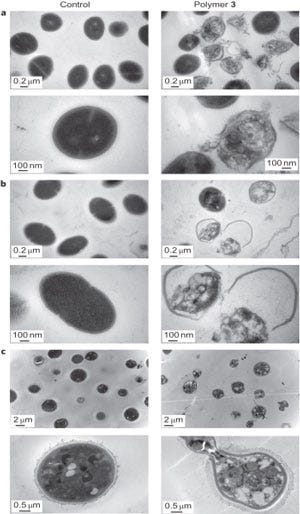Ninja Polymers Create Superantibiotic to Squash Superbugs
December 19, 2013
Researchers at IBM Research - Almaden (San Jose CA) and the Institute of Bioengineering and Nanotechnology (IBN; Singapore) have discovered a new superantibiotic derived from ordinary polyethylene terephthalate (PET), a common, and commonly recycled plastic. In a paper in Nature Communications the group describes their work and testing on mice with eyes infected with Candida Albicans.
Dubbed "ninja polymers" by the scientists, they attack pathogens in a unique way. Whereas "normal" antibiotics basically work by poisoning the infection and disrupting reproduction, ninja polymers attract the attackers with an electrical charge, then chemically rip open the cell walls so the contents spill out harmlessly. Then, like the ninjas of legend they just fade away, degrading into harmless compounds that can safely be eliminated. Two videos explaining the development accompany the release on IBM's Web site.
|
Comparative transmission electron microscope (TEM) images of microbes in the absence and presence of polymer 3. (a) MRSA, (b) Enterococcus faecalis, and (c) Cryptococcus neoformans before (left) and after incubation (right) with polymer 3 for 8 hours at lethal doses. After treatment, cell walls and membranes were damaged, and cell death was observed. (Photo courtesy of Nature Chemistry and the authors) |
These new polymers, first identified in IBM's chip development research, link together in water to form a "sticky nanostructure," a positively charged synthetic hydrogel of nanofibers that are attracted to negatively charged microbial membranes. In previous work IBM and IBN researchers published a paper in which a similar polymer was shown to be effective against MRSA infections.
"The mechanism through which [these polymers] fight bacteria is very different from the way an antibiotic works," explains Jim Hedrick, a polymer chemist at IBM Research, in a press release. "They try to mimic what the immune system does: the polymer attaches to the bacteria's membrane and then facilitates destabilization of the membrane. It falls apart, everything falls out and there's little opportunity for it to develop resistance to these polymers." C. Albicans developed resistance to a widely used antifungal drug after six treatments, it did not develop resistance to the new compound even after 11 treatments, the team reported.
In a 2011 paper published on Medscape, Daniel H. Kett, MD, et al. said that "Candida bloodstream infections (BSIs) and other forms of invasive candidiasis are the most common invasive fungal infections among hospitalized patients." If these new polymers pan out, yet another scourge of mankind may soon be a thing of the past.
About the Author(s)
You May Also Like


